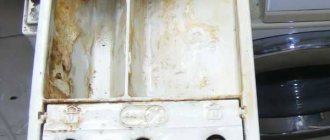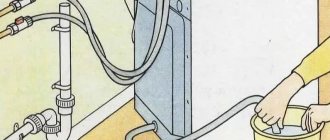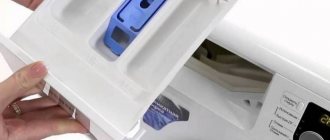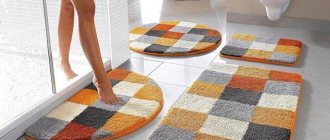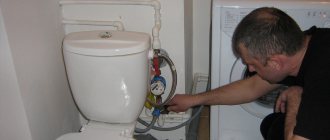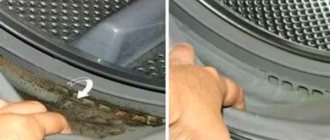It is not recommended to leave the washing machine in an unheated dacha or country house at low temperatures. The service life may be reduced and local failure may occur. To prepare for storage means, first of all, to remove any remaining moisture from it. Therefore, it is necessary to open the filter plug or unscrew the pump plug. They are usually located on the facade at the bottom left or right. Information on how to drain the water from the washing machine is contained in the instructions.
You should also dismantle the water supply network to the machine and remove any remaining water from the inlet (numbered in the figure 1) and drain (2) hoses. The first must be completely unscrewed, and the second must be disconnected and placed on the floor, lowering the end into a suitable tray.
It is very important that no water remains in the inlet valve. This valve is located under the top cover of the machine. The inlet hose is screwed directly to it. The figure shows how to remove the top cover of machines from the Indesit line and many other types. Namely, self-tapping screws a and b are unscrewed, the cover moves and rises according to the arrows.
The controlled inlet valve is connected here using connectors and wires to the rest of the electrical circuit. It is connected to the inlet conduit using flexible tubes. The wires and tubes must be disconnected and the valve itself removed. It is usually secured with screws and can be three-chamber, as shown in the figure, but also two-chamber and single-chamber. Depending on the type, instead of tubes, installation is found in the water pipeline through gaskets. It is important that the operation of removing and installing the valve is not very complicated. But, shaking out the remaining water from the removed valve is much easier.
You don’t have to remove the valve, but blow the line through the inlet hose with a pump or your mouth. The machine should then be turned on for a while in the washing or rinsing mode and wait until it clicks. The advantage of removing it is that the ventilation of the insides improves. By the way, it is better to leave the unit for the winter with the loading hatch slightly open and the pump cap turned out.
You can protect your washing machine from significant winter temperature changes by placing it in a polypropylene bag for construction waste (120 l). In this case, the bag is blown with warm air from a household hair dryer for several hours, and then sealed hermetically.
Whatever preservation method you choose, it is advisable to first consult with a specialist. Their experience in spring repairs of products of exactly your type will tell you the optimal behavior. Good luck to you!
Source: manualbase.ru
How to maintain a washing machine?
How to extend the life of a washing machine: 8 useful tips
- Correct installation
- Before washing, check pockets, fasten zippers and unbutton underwear
- Do not overload the drum
- Use detergents correctly
- Protecting your machine from hard water
- Prevention of mud deposits and scale
Interesting materials:
What is the best motherboard? What are the best tires for summer? What is the best facial serum? What is the best mascara for volume? What is the best Maybelline mascara? What are the best skincare products? What is the best dental floss? What is the most reliable foreign car? What is the most reliable car in Russia? What is the most reliable German car?
Conservation of equipment
Of course, stories about how frosty condensation disables all the hidden parts of a car and simply kills it from the inside have a basis, but you shouldn’t be too afraid of this.
Proof of this is the store warehouses. It happens that devices sit there for a long time before they get into the showroom of a household appliance store, and storage areas, as a rule, are not heated even in winter. Equipment does not deteriorate at sub-zero temperatures, although it is tested before release and, accordingly, has water inside. But, being a simple man in the street, you still need to play it safe. Preserving your car for the winter is quite simple.
- Disconnect the unit from the water supply, and then pour 50 grams of car antifreeze into the water supply hose.
- Straighten the sewer hose as much as possible so that all the liquid comes out.
- Next, you need to pour a glass of anti-freeze directly into the drum of the machine. This is approximately 250 grams.
- Connect the device to electricity and run one of the basic washing programs.
- When the machine “tries” to fill the drum with water, blow out the hose and valve.
- Turn on the spin cycle. With its help, the antifreeze will penetrate inside, into the pump components.
After all procedures, be sure to disconnect the machine from the electrical power supply.
As you can see, preparing SM for winter at the dacha is quite simple, and you don’t have to worry about its safety. When it's time to actively use the washing machine again, don't forget to run it empty before loading and washing items. The non-freezing automotive fluid must be completely removed from the system . An “empty” wash will do the job perfectly.
Preparing for winter in case of conservation of the dacha
In general, a dacha is not just a place for a family’s summer stay. Rather, it is a special place where you can feel unity with nature. And also relieve stress from being in the metropolis. The dacha can be seen as a remedy against the crisis...
Thoughtful preparation of a dacha for winter can be considered the basis for a competent meeting of the cold season. After all, engineering systems at the dacha need protection. And in cold weather they can fail if they are not prepared.
The process of preserving a summer house for winter consists of several steps. Each of them is important. And they must be carried out in strict accordance with the safety requirements and safety of devices and assemblies. Let's consider what actions need to be performed in the fall at the dacha.
Draining water from the water supply
Leaving water in the pipes means you will get a huge number of problems in the spring. A burst pipe is by no means the most pleasant surprise for a summer resident. How often does a sewer rupture occur if the dacha has not been prepared for winter?
It is water that can cause the most trouble. After all, when it freezes, it increases in volume and is capable of destroying even the strongest connections. Therefore, draining the water from the water supply should be considered the most important component of preparing the cottage for the winter.
The sequence of actions is as follows:
- The check valve stops operating. He is responsible for the flow of water from the well into the house;
- when installing your own well, the water will then drain into the drain;
Your own well allows you to get free water in unlimited quantities. Such a pleasure is not cheap... However, it is quite possible to equip your own well with your own hands. Read about it in the next article on our site;
- in the absence of such a valve, you will have to disassemble the water supply unit into the house manually. And then drain the water from it.
After draining the water from the water supply, you will need to disassemble the filters. They come after the hydraulic accumulator. The cartridges are removed from the filters, cleaned and sent for storage.
Preparing the pumping station for winter
The presence of a pump in the house will require freeing it from water. Preparing a pumping station for winter at a dacha when it is located in a separate well will not require any action at all. After all, the pump is mounted at a considerable depth. And the soil freezes no more than 1.5 m (information for the Moscow region).
However, many summer residents prefer not to take risks. The pump is removed from the well and water is manually poured out of it. And all equipment is stored in a warm room. Of course, such storage would be preferable.
Washing machine: preparing for winter
Preparing a washing machine for winter at the dacha also requires certain steps. Some manufacturers note in a separate paragraph in the instructions that the unit can remain in an unheated room.
However, often there is no such footnote. What will need to be done? Preparing the washing machine for winter is carried out as follows:
- the “Water drain” operating mode is switched on;
- at the end of this mode, you should disconnect the machine from the network and sewer;
- open the hatch for additional cleaning. Also drain the water from there and remove the garbage;
- To be more sure, you can turn the machine upside down.
Now your washing machine is ready to face the cold. And it will retain its functionality by being completely removed from its water.
When choosing a washing machine, many are lost in front of the variety available for sale. Which one to choose: front loading or vertical loading.
Preparing your dishwasher for winter
The process of preparing a dishwasher for a cold period is similar to a washing machine. Drain the water completely! Even a small amount can quickly damage the unit. After all, if the water remains, even in small quantities, in small tubes inside the machine, it will freeze and burst it. And replacing such small pipes can be very problematic.
As dishwasher owners say, inside these units there are real labyrinths of water tubes. And if you are not sure of the complete absence of water inside the machine, it is better not to risk it. And take the cars into the city to a warm room.
Preparing a toilet in the country for winter
The toilet also needs to be prepared for frost. After all, there is a large amount of water inside it.
You will need to remove water from the drain tank. It is in it that its significant reserve is stored. To do this, you will need to drain the water from it several times. Then turn off the water supply to the toilet and drain the remaining water again. Now you need to scoop the water out of the toilet bowl. You can use a homemade scoop. You can make it from an unnecessary plastic bottle. But any means will do.
Now we wipe the toilet dry inside and out. To prevent sewer odors from penetrating into the room in winter, we plug all the toilet openings with rags. You can also cover it with rags on top.
Now the toilet is ready for winter. Let us add that some dacha owners use the following two methods of preparing the toilet in their dacha for winter:
- Instead of water, non-freezing liquid is poured inside the toilet. It is made on the basis of alcohol. This allows it not to freeze even in severe frosts. A car “anti-freeze” is usually used.
- Some people also add 10% salt to the same “anti-freeze”. This gives additional confidence that the liquid will not freeze. In addition, salt will prevent the liquid from freezing if the alcohol component in the “anti-freeze” has evaporated.
The tips given have been tested by many dacha owners. Maybe our readers will share tips on preparing the toilet in the country for winter?
We insulate the septic tank and sewerage system
Winter can be different. However, this year weather forecasters promise a very harsh winter... And it will be necessary to protect the sewer system from the negative effects of frost.
What will it take? When installing sewers and wells, insulation is much more convenient. But you can do this work later. To insulate, it will be necessary to unearth the rings and remove dirt from them. It is advisable to dry the reinforced concrete rings. Now let's proceed directly to the insulation.
Any insulating material should be applied to the surface of the rings. This could be regular foam. Or you can choose more modern materials with better insulation. For example, expanded polystyrene foam. The material is attached with strong glue. For better fastening, concrete dowel nails can be used. The joints between individual parts of the material are filled with polyurethane foam or sealant. Dry again. Now our well and septic tank are ready for even harsh winters.
The owners of their own houses and dachas give the following advice. The area around the septic tank or well should also be insulated. You can use the same foam. However, the best option is penoplex. This material is more resistant to external influences and has increased thermal insulation. You can put a layer (100 mm) on top of the hatch cover. This measure will also protect the well from freezing. As an option, during heavy snowfalls, throw a thick snow cushion on top of the hatch.
The following tips will help your cottage survive the winter. And even severe frosts will not damage equipment and utility networks.
Vodoprovod i Co.
When water freezes and turns into ice, it greatly increases in volume. Even the thick metal walls of pipes and barrels cannot resist this expansion! So that in the spring you do not have to repair the water supply and purchase new expensive pumps and heaters to replace hopelessly damaged ones, you must carefully get rid of all the water remaining in them.
How to drain water from...
- summer water supply . It’s good if in your gardening it is common and the blowing is carried out centrally. Then, by the appointed date, simply open all the taps (remembering to remove the connecting elements with the AquaStop system from the hoses). If there is no one other than you to prepare the system for winter, disconnect the pipes or hoses from the water source and blow them out with air yourself.
- equipment for water supply and irrigation : pumps, filters, drip irrigation control devices, etc. preserved for the winter. As a rule, it is quite easy to partially disassemble them and shake out the remaining water, but some will have to be blown out. By the way, this is a good reason to wash all the parts and, if necessary, rid them of lime deposits and rust.
- storage heaters . They are usually equipped with a special drain valve, and the entire process is described in the instructions. But if there is no such valve, the water is drained through a pipe or hose through which cold water enters the heater (precisely cold water - hot water is taken from the top of the tank). At the same time, the hot water tap must be opened so that air enters the tank and water flows well. Advice : when installing a new storage water heater that does not have a drain valve, install a tee at the “entrance” to it with a separate tap for draining water - then you will not need to unscrew the pipe system every year.
- washing machine and dishwasher . Disconnect the hose through which water is poured in and run the machine on any program. When the machine tries to fill with water, bleed the inlet valve, and then immediately turn it off. After this, disconnect from the sewer and lower the drain hose to the floor, unscrew the filter (washing machine) and, shaking the housing, drain the remaining water. Separately blow out the hoses with the aquastop system. Important: designs may vary! Carefully examine where else water may accumulate. In dishwashers - under the filter mesh and in a plastic container into which salt is poured: the remaining water from them, as a rule, has to be sucked out with a rubber bulb, a large syringe or a wet vacuum cleaner.
- flush toilet with urban toilet . Do not forget to remove water not only from the tank, but also from the bottom of the toilet and the bent pipe elbow - the water seal. This can be done using a rubber bulb, a rag or a foam sponge. To prevent odors from the septic tank from entering your home, plug the hole with a dry rag or sponge. Check the siphons of all sinks, showers and baths - if there are water seals there, you should do the same with them.
Country electrics
Turning the switch to turn off the lights and hanging locks on the doors is not enough to ensure the reliable safety of your electrical appliances and ensure the safety of the entire home. Don't forget two more things.
1. Protect electrical appliances from moisture . Start preparing for winter by installing good ventilation in the rooms where all your country equipment will spend the winter. High air humidity is the enemy of any metal parts and electrical contacts! After turning off and wiping the inside of your refrigerator, microwave, or electric oven, be sure to dry them thoroughly or leave the doors ajar. Ventilation requirements also apply to the utility room or storage room where garden power tools are stored.
2. Disconnect them from the network . Unplug all electrical appliances from the sockets (TV, microwave oven, multicooker, chargers, heaters with electronic control units, etc.). Even if the power in the house is turned off, devices plugged into the outlet may be damaged, for example, during a thunderstorm or a serious power failure.
Turn off the circuit breakers. If some devices need to be left operating for the winter (for example, an alarm system), it is advisable to organize a separate line for them, coming from the panel, and install a circuit breaker of suitable power on it, as well as a residual current device (RCD). It is better to entrust this to professionals.
What if you just drain it?
Of course, the word “drain” sounds much simpler to an ignorant person than “preserve.” However, in reality this is not the case. If you correctly understand the mechanism for preserving a machine for wintering in an unheated room, you can do it in an hour, but it will take several days to dry and ventilate the machine:
- First of all, remove the tray from the niche and unscrew the filter. In this case, the water will not freeze, respectively, in the tray and at the bottom of the tank.
- Next comes the drain pump. It also needs to be unscrewed and left to dry. In case of freezing, the impeller will be damaged, which will make the operation of the entire SM impossible.
- Now disconnect from the water supply, unscrew the drain and inlet hoses and completely empty the liquid. Screw it into place.
- To get water out of hard-to-reach places, tilt the machine forward. The pipes and the snail will free themselves from moisture.
- An important detail is the hatch cuff. If water freezes on it, the part can dry out, crack and lose its seal. In this case, the hatch simply will not close, and the machine will refuse to wash.
You can dry the cuff by carefully walking over it several times with a dry cloth or napkin.
After the procedure has been completed, the machine still needs to be ventilated. To do this, open the door wide and leave the unit in this position for 2-3 days. Only after this can you cover the machine with polyethylene and leave it in an unheated room.
Passion by tension
If you are going to come to your dacha during the cold season, and the voltage in the network of your village or SNT “jumps” or “sags” (this becomes especially noticeable when neighbors start turning on the heaters en masse), it makes sense to get a voltage stabilizer. Its power is selected by summing up the energy consumption of those devices that you usually turn on.
In difficult conditions, the following cannot be done without a stabilizer: a TV, a refrigerator (especially new models), a computer, a microwave oven, a stove or a stove with induction burners. Heaters (without an electronic control unit), a kettle, and a simple electric stove do not need a stabilizer, although at reduced voltage they will heat up more slowly.
Preserving a car for the winter: 7 main rules
Is it necessary to prepare a car for long-term parking? Of course yes! Even if it is modern and sophisticated.
“...I bought my first car - a yellow three-ruble car.
Absolutely trouble-free! It always started - even when I left it for six months in Moscow in the winter!” Mikhail Zhvanetsky
Drivers who do not use a car from autumn to spring were previously called “snowdrops” by professionals. However, among car enthusiasts these were the majority: only a few drove their cars all year round. And this was understandable: in those days people bought a car, as they say, for life, and therefore no one wanted to kill it with winter driving. In addition, no one had really heard about winter tires at that time, and the main route of travel was the dacha, which was also inactive in winter. And there were no normal oils or antifreeze.
Today no one will believe this: driving almost everywhere has become year-round. But nevertheless, a cohort of lucky cars that are not used in winter still exists. People have different reasons: some people still travel only in the summer from and to their dachas, others periodically go on long business trips and other voyages, others simply want to take a break from their personal car for at least a few months a year. But they all have to solve the same problem: what can be done with the car now so that they can safely start using it in the spring?
If you delve into the literature of past years, you will get the impression that the conservation of a car is a kind of natural disaster. Drain the water, pour oil into the cylinders, plug the muffler with oily rags, put the car on trestles, unloading the suspension, take the battery home, etc. Well, at that time the advice was appropriate. However, modern cars make the task somewhat easier. In my opinion, it is enough to pay attention to the following fundamental circumstances.
How to prepare the engineering systems of a dacha for winter
The anticipation of winter entertainment can bring joy when proper preparation for winter has been carried out. Thanks to a number of specific activities, you can not be afraid of the cold. And also prevent the risk of freezing of engineering systems if you plan not to visit the dacha in winter. How do you prepare for winter in a private home? What steps does the algorithm for such preparation consist of? Experts will talk about this and much more in our article today.
Accumulator battery
The battery must be fully charged - this is an indispensable condition. There is no need to remove it from the car. If the car is not very sophisticated, then it is advisable to simply disconnect the battery terminals: in this case, its discharge will be as minimal as possible, especially in the cold. However, not all cars allow you to do this painlessly: there are cases when, after removing the power, the processor was blocked and the intervention of servicemen from the head office was required. I also encountered another situation: after disconnecting the battery, a brand new car suddenly began to scream, and the confused servicemen after the meeting remembered that it had two batteries installed, and the circuit design features were such that... well, in general, there was no need to disconnect anything!
Indeed, you don’t have to turn anything off. We conducted a large-scale study that showed that almost any modern car will last in this condition from several months to six months or more. However, it is highly advisable to still visit the car at least once every couple of months and run the engine for half an hour. It will not be worse.


